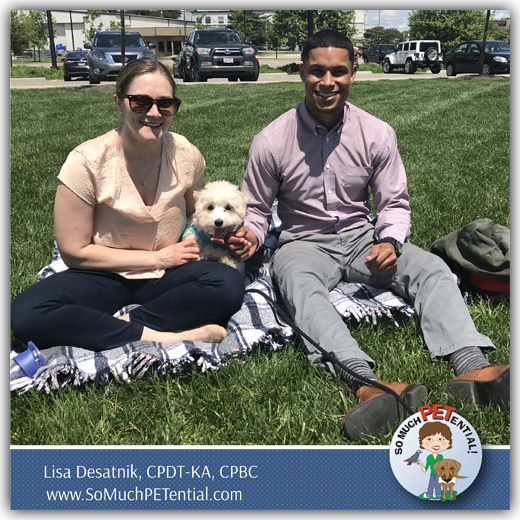What do you use as reinforcers for your dog to walk with you on leash?
Don’t forget a reinforcer can be all kinds of things in the environment. Does your dog like to sniff fire hydrants? Super! If your dog walks on a loose leash toward the next hydrant, you can tell your dog to go sniff it. Getting that opportunity to sniff the hydrant as a consequence then can be a strong reason for your dog to want to do a behavior that you want your dog to do.
Dawson, my maltipoo, finds so much joy in meeting new people that I often use that as part of his training. If  people appear interested in wanting to meet him (or I may just ask them), I will ask if I can walk him to them. If he pulls, we turn around and try again. The opportunity to get to ‘Say Hi’ to people is a pretty high value consequence for Dawson to walk on a loose leash so he often will walk with me to them.
people appear interested in wanting to meet him (or I may just ask them), I will ask if I can walk him to them. If he pulls, we turn around and try again. The opportunity to get to ‘Say Hi’ to people is a pretty high value consequence for Dawson to walk on a loose leash so he often will walk with me to them.
He still needs reminders sometimes but the more we practice the more he is learning. In the photo are a couple of Dawson’s newest outing friends, he met them by walking with me to where they were sitting.
Those are a few examples of the Premack Principle, which states that the more probable behavior will reinforce the less probable behavior. Were you ever told as a child that if you clean your room, THEN you can do something fun? Or that if you eat your vegetables, THEN you can have desert? Have you ever told yourself something like, when you finish your tax preparation, THEN you can do another activity? Yep, those are also examples of the Premack Principle too!
It is a pretty powerful training tool. However, here are a few dog training tips to keep in mind when using it.
What behavior are your trying to strengthen? Whether your goal is for your dog to come when called, sit or lay down when asked, or something else, spend time teaching your pet what that behavior should look like with lots and lots of repetition with positive reinforcement. I work with Dawson a lot in a variety of settings on the behaviors of sit, down, wait, and come (as examples) so that he has an understanding of those behaviors when I ask him to do them in the presence of those other distractions or stimulus.
Know what your dog values. You can learn this simply by observing your dog. Does your dog have a favorite toy? Is your dog indicating an interest in smelling a bush? Is your dog ready to run out the door or jump into a car the minute your walk toward it? If so, ask your dog to do a behavior before giving your dog the opportunity to do that activity.
Help your pet to succeed by using a stimulus that will not be too difficult for your pet. In other words, if your dog is so distracted by that stimulus (such as a fire hydrant, a person walking by, or another dog nearby), practice with a less valued stimulus first (instead of sniffing the fire hydrant, maybe practice with a patch of grass or piece of food on the ground) or practice doing the ‘wanted’ behavior (like sitting or walking on a loose leash) at a further distance from the stimulus and then releasing your dog to go sniff the fire hydrant. Or practice asking your dog for an easier behavior such as a hand target and then releasing your dog to go sniff.
There are still a number of other issues I am working through with Dawson, and there will always be different behavioral issues crop up throughout our life together. I look for ways I can teach him what I want to see him do by pairing that with something he values.







